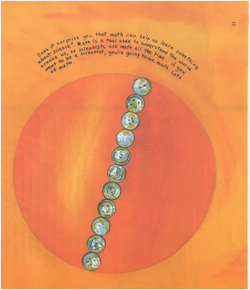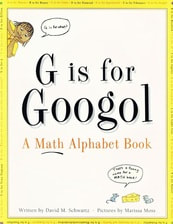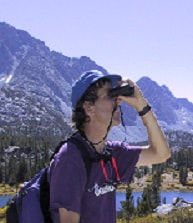|
Imagine Earth as a button. I don’t mean you’re going to sew it onto your shirt. But imagine the planet Earth shrunk to the size of a button. (Of course Earth is not flat like a button but we’re giving our shrunken Earth the same diameter as a shirt button.) Go ahead and draw a circle around a shirt button. Call it “Earth.” Suppose you wanted to draw Jupiter, the largest planet, at the same scale as this micro-Earth. That means you’re going to shrink it to the same fraction of its original size as our button-Earth. What size would little Jupiter be? One way to find out would be to calculate how many times bigger the real Jupiter is than the real Earth. Earth’s diameter is about 8,000 miles (13,000 kilometers). Jupiter’s is about 88,000 miles (143,000 km). Divide the size of Jupiter by the size of Earth to see that Jupiter is about 11 times bigger. So, since Jupiter’s diameter is 11 times that of Earth’s, put 11 buttons in a line to show the diameter of Jupiter. Then draw the circle that represents Jupiter. If you don’t have 11 buttons, just look at the picture. Did you think the Earth was a big place? Look at it compared with Jupiter! But what about the sun? The sun’s diameter is about 865,000 miles (1,400,000 km). That means it’s almost 10 times bigger than Jupiter. Can you find a way to draw a circle 10 times the size of our Jupiter? We’ve drawn part of it for you, on the same scale as our button-sized Earth. On the picture, it’s labeled “our arc.” (An arc is part of a circle.) Looking at the arc, you can imagine the rest of the circle and compare the sun to Jupiter and Earth. A minute ago, you thought Jupiter was big. Now it looks shrimpy compared to the sun! But is the sun really gigantic? Do some research to find out the size of a red giant star like the strangely named Betelguese (pronounced “beetle-juice.”) Figure out what it looks like compared to our sun, which is a medium-sized star. You may be amazed at the difference. And you thought the sun was big! Is anything truly big? Is anything truly small? Or does that depend on what it’s being compared to?  Both images are by Marissa Moss, the illustrator of David M Schwartz's book, G is for Googol. If the Earth were the size of a button, Jupiter’s diameter would equal eleven buttons because the diameter of Jupiter is eleven times that of Earth.  G is for Googol: A Math Alphabet Book is a wonder-filled romp through the world of mathematics. For more information, click here. David Schwartz is a member of iNK's Authors on Call and is available for classroom programs through Field Trip Zoom, a terrific technology that requires only a computer, wifi, and a webcam. Click here to find out more.
0 Comments
Leave a Reply. |
Check out our new podcasts in the iTunes Store and on KidLit Radio.
|





 RSS Feed
RSS Feed
